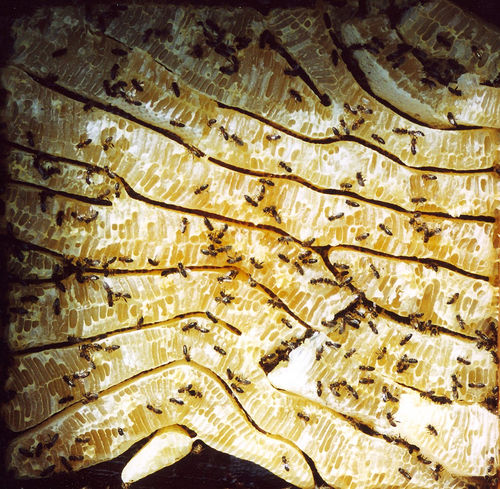
A rare cross-sectional glimpse of natural honeycomb construction. (Photo by Max Westby.)
In 2009, lifelong beekeeper Dan Harvey faced an existential crisis when he lost much of his honeybee stock to colony collapse disorder (CCD). So the former Vietnam-era Special Forces veteran did what came naturally: He took to the deep dark woods of the Pacific Northwest, searching for answers to his predicament.
Harvey began by hunting for wild and feral bees living near his home in Port Angeles, Wash. (These bees have escaped from commercial colonies and find refuge in the tall timber and glens enveloping the Olympic Peninsula). For years, he crossbred the feral bees he captured with honeybees in order to produce hybridized hives that would be well-suited to the dank climes of the temperate rainforest region.
Then one day Harvey discovered an isolated hive full of bees he claims are highly resistant to Nosema ceranae, a pathogen and debilitating fungus considered one of the many threats related to CCD.
“The fungus would lodge in their gut, making the digestion of pollen impossible, leading to die-offs,” Harvey explains. But since he’s introduced the wild bees, his colonies have been on the rebound — no small feat in today’s bee climate. Now, three years after the initial crossbreeding took place, the offspring are proving themselves to be survivors.
At a time when honeybee populations are dwindling, and bees continue to abandon doomed hives, and the link to agricultural pesticides is stronger than ever, news of these disease-resistant bees has resulted in local and national media coverage.
According to the Department of Agriculture, CCD has accounted, at least in part, for 30 percent of bee losses annually, since 2007. It’s also jeopardizing beekeepers, rural economies, and the farm communities that depend on those bees. Worldwide honeybees pollinate 400 crops, while adding an estimated $15 billion in revenues per year to the U.S. farm economy.
Despite their pastoral image, the burden placed on the domesticated honeybees is a weighty one. Bred for their non-aggressive demeanor and ample honey production, they’re also expected to help propagate tens upon of thousands of acres of flower-pollinated crops on farms throughout the U.S. and Europe.
As scientists and beekeepers have been literally and figuratively beating the bushes to understand CCD, they’ve often turned to the role genetic diversity plays in the overall health of bee colonies. And recent research published in the peer-reviewed science journal PLoS ONE suggests honeybees are as adverse to monogamy as they are to monocrops. In fact, mixing it up, so to speak, can yield unexpected and surprising benefits for honeybee populations. Honeybees — whether feral or domesticated — need variety. Not only do worker bees spend their waking hours hopping from plant to plant, but some queen bees are also promiscuous, mating with multiple males in a brief period of time. And, as it turns out, there’s a biological rationale for this promiscuity; the overall fitness of the hive depends upon these multiple partners.
“Most bees, ants, and wasps mate singly. Honeybee queens are different in that regard — producing highly productive hives that dominate their landscape,” says Heather Mattila, a researcher at Wellesley College.
In the study published in PLoS ONE, Mattila and her co-author Irene Newton found that bees — like humans and other species — depend on helpful bacteria to aid in digestion. And the genetically diverse bee colonies they studied had a significantly greater number of probiotic species living in their guts than the more uniform hives. Moreover, the uniform beehives were 127 percent more likely to contain harmful pathogens than their more diverse counterparts.
“We’ve never known how genetic diversity leads to healthier bees, but this study provides strong clues,” says Matilla.
Unfortunately, most honeybee hives are of the uniform type. Early settlers brought just one subspecies known as the “dark bee,” Apis mellifera mellifera, with them from northern Europe to the Jamestown colony. It remained the only honeybee in the U. S. until the introduction of the Italian honeybee, Apis mellifera lingustica, in the mid-19th century. Today, the latter is the most common.
Susan Cobey, a bee breeder and geneticist at UC-Davis, believes the recent findings underscore the complex nature of honeybee societies. Her own research has taken her as far afield as the Republic of Georgia’s Caucasus Mountains in search of honeybees possessing beneficial genetic traits.
A 1922 U.S. ban on the importation of bees and the overreliance on a subset of honeybees bred for ease of handling and productivity has led to genetic “bottlenecks” limiting genetic diversity, she points out. Speaking metaphorically, she adds: “It’s like you had one boatload of people come over here that populated the whole U.S. and no one else is allowed in.”
After 500 years of only two types of honeybees dominating the landscape in the U.S., the thinking goes, the lack of genetic diversity is weakening their ability to resist CCD.
To get around the bottleneck, Cobey’s work focuses on enhancing honeybee stocks through the manipulation of bee semen to widen the gene pool. With the help of beekeepers overseas, she’s importing the germplasm of a subspecies of honeybee known as Apis melliflora caucasia, which is native to the fringes of southern Europe. “They’re providing the best of their stock,” she says.
Not that there’s one simple fix for CCD. Diversity is just one part of the equation. “A lot has to do with pesticides and nutrition,” Cobey adds. “The amazing thing about bees is they bounce back [for a while]. But at some point they collapse.”
Scientists and beekeepers alike are working furiously to prevent that from happening. But in the meantime, it might be wise to ask: What if we turned back the clock on agricultural production and allowed honeybees to forage and frolic more freely?



